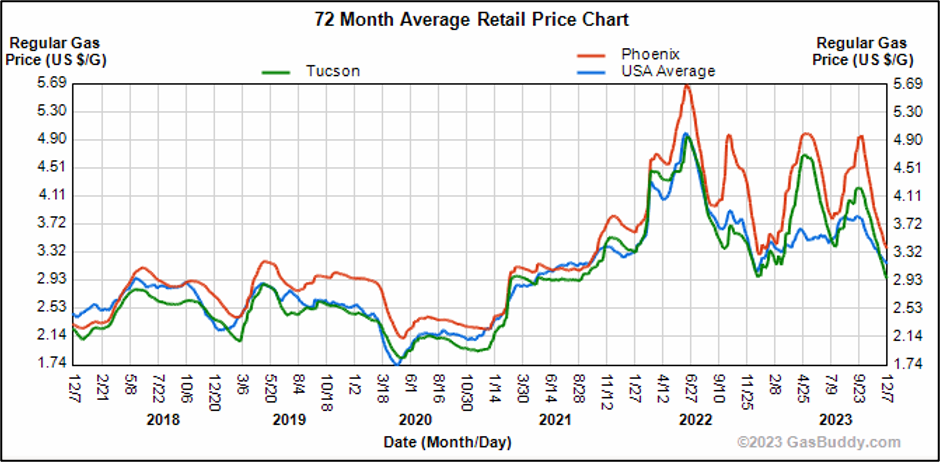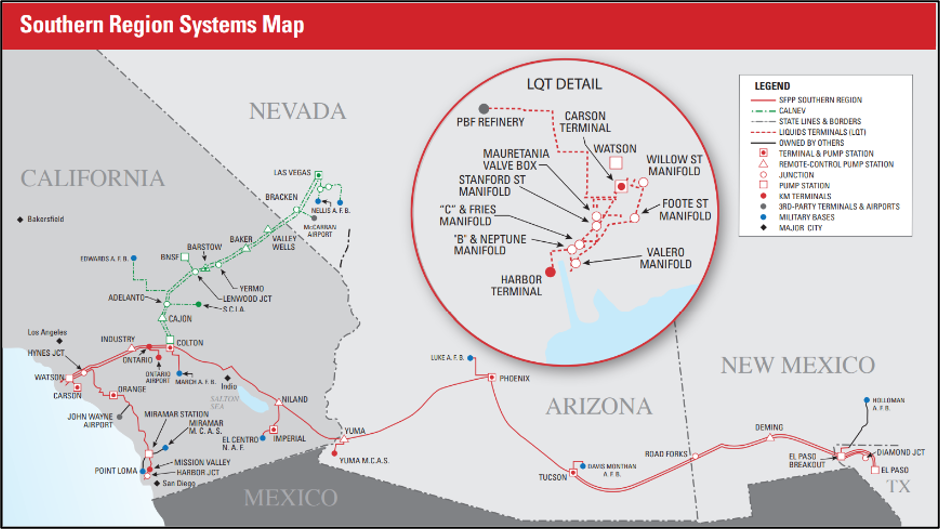What’s causing Arizona gasoline prices to spike, and what can be done about it?
Link to article: https://stillwaterassociates.com/whats-causing-arizona-gasoline-prices-to-spike-and-what-can-be-done-about-it/
January 10, 2024
The last several months have shown a decrease in gasoline retail prices on average across the U.S. – which is great for consumers! Unless you live in Arizona, in which case you are still feeling the squeeze of higher gasoline prices. The figure below, from GasBuddy, shows retail prices over the last six years for the entire country on average versus Phoenix and Tucson:

You can see the magnitude of the price spikes in April and September were significantly larger in both Phoenix and Tucson. Why would Arizona be seeing higher price spikes than the rest of the country on average? One theory is that Phoenix uses a boutique fuel – a cleaner burning gasoline (CBG) to help reduce air pollution to meet federal air quality standards – which could cost more; but Tucson uses conventional gasoline – so boutique specifications can’t be the crux of the issue here.
The Real Issue: Pipeline Constraint
Arizona is dependent on refined product imports – primarily by pipeline. The figure below from the Kinder Morgan Pacific Operations Manual shows the pipelines going into Arizona from California and Texas.

Short-term pipeline issues, such as leaks, can cause spikes in retail gasoline prices as these issues temporarily decrease supply while demand remains relatively constant. In the short term, some refined products could be trucked in or delivered by rail, but at higher cost and in smaller volumes.
A more chronic issue is the fact that pipeline volumes are finite while demand is increasing. From 2012-2021 U.S. gasoline demand increased 4%, while Arizona demand increased 16% due to population growth. According to the U.S. Census, the population in Arizona increased by 15% from 2010 to 2022, compared to the total U.S. population increase of 8% over the same period. As population increases, so does the demand for gasoline, but due to infrastructure constraints, supply simply cannot increase to match demand. In fact, supply has decreased since late 2021 because of a Pipeline and Hazardous Materials Safety Administration (PHMSA) letter requiring Kinder Morgan to reduce pipeline pressure. According to the letter, Kinder Morgan must reduce operating pressure by 20% in any pipeline segment where PHMSA found anomalies. One affected section is part of the East Line that goes from El Paso, TX to Tucson. The purpose behind this is to reduce the risk of leaks while Kinder Morgan investigates and repairs (if necessary) the anomalies. The only way to reduce pressure in the pipeline is to reduce volume – which wouldn’t be a problem if demand was constant or slowly decreasing. But Arizona’s increasing population is causing further supply constraints in the Arizona markets. Trucking in additional supply is not a viable solution to this long-term problem since it costs about ten times as much to ship gasoline from El Paso to Arizona by truck as by pipeline – and that cost would be passed on to the consumer.
What Is The Solution?
In order to meet increasing demand, supply needs to increase accordingly. As a stop-gap measure, additional gasoline supply can continue to be trucked in, although this will come at a premium. Changing gasoline specs – from CBG to conventional gasoline – in Phoenix would unfortunately not help appreciably because the infrastructure issues around getting that gasoline into Arizona would still exist. Furthermore, Tucson is already using conventional gasoline and is also seeing retail price spikes. The only potential fixes are to increase pipeline capacity or decrease fuel demand. Since Arizona’s population growth doesn’t seem to be reversing, that leaves us with expanded supply capacity as the only viable solution. According to an article in OPIS, Kinder Morgan is looking at expansion between El Paso and Tucson.1 This would allow for higher volumes of gasoline to be imported into Arizona to meet the increased demand. If supply and demand increase in tandem, the frequent and large retail gasoline price spikes should – in theory – subside.
1 Kloza, Tom. “Kinder Morgan Soliciting Commitments for Line to Tucson, Ariz.” OPIS, 2023-04-12.
